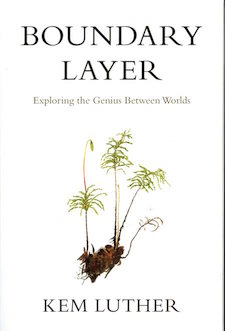Boundary Layer—Exploring the Genius between Worlds
Last Updated on November 21, 2022 by

by Kem Luther
ISBN 978-0-87071-844-1
Oregon State University Press, Corvallis, Oregon, 2016
The book comprises seven essays on diverse concepts that the author thinks of as metaphors for “boundary layers,” e.g., Dune ecosystems between land and water, Mosses (the bryosphere), Fungi, European and American views on ecosystems, Lichens with the species-ecosystem boundary, and Wilderness with human influence boundaries. The author, Kem Luther, has a background in philosophy and now considers himself a field naturalist and gives talks on mosses and fungi. Each essay consists of a pastiche of interviews of people who care passionately about specific places or organisms, accounts of field trips including details of shopping and driving, extensive and diverse historical researches, botanical lecture content, and personal reflections. All of the characters interviewed and all the sites visited are in British Columbia (where the author now lives). The most interesting parts are the descriptions of the private lives of people obsessed (in a good way) with lichens or dunes or fungi or ecosystems. He definitely succeeds in digging into the fascinating people who hug the ground-hugging organisms. I am such a one and so find them sympathetic. I also know several of them and he gets it right.
I found it difficult to figure out what this book is about. The title, “Boundary Layer,” suggests air flowing over a leaf surface or through fur, or maybe the boundary sediment between geological eras. The preface begins with a definition of stegnon —a word not in my 4-inch thick Random House Dictionary, not in dictionary.com, and, though sounding Greek, not in online Greek-English dictionaries. It was listed in Sources at the end of the book as from an email in 2012 from Trevor Goward. Not something one could look up. The preface changes to an account of Europeans moving into Canada in the 1850s. Hmm. Finally, the author paraphrases stegnon as the land cover of mosses, lichens, fungi, and small plants. The back cover of the book refers to the stegnon as “the terrestrial equivalent of oceanic plankton.” That is too much of a stretch, even for a metaphor. Planktonic organisms are the basis of oceanic food chains. Mosses and lichens and fungi are not the basis of terrestrial or even ground-hugging food chains. Big plants do not eat little plants. He does not explain this metaphor. He refers to these organisms as “the precondition and foundation of biotic life.” I have no idea what the words mean. Primary succession on basalt? The origin of life in the universe? He does not elaborate.
However, the chapters do not directly apply the terms genius between worlds or stegnon again. He says that he will test the limits of the language of biology, a subject that he has taught. He succeeds in that. Once you get through the metaphors and plays-on-words, the writing is clear and thoughtful if idiosyncratic in its assemblage. As the book progresses, the concept of “boundary layer” becomes more generalized until its meaning encompasses too much, and we end up with reference to C. P. Snow’s The Two Cultures.
The prose pages are broken up with eclectic black-and-white photographs ranging from Andy MacKinnon to Aldo Leopold and from scanning electron micrographs of mycorrhizae to an 1867 microscope. There is no alphabetical bibliography and no index. The Sources section gives occasional references to numbered pages. I found the book rambling and without a clear focus. Perhaps that is a virtue. It offers glimpses into the brain workings of a raconteur. And it reminds us to look closely at the small things and reflect on their place in the larger world.
—Darlene Southworth, Siskiyou Chapter.
